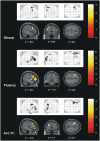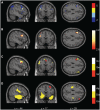Executive deficits are related to the inferior frontal junction in early dementia
- PMID: 22184615
- PMCID: PMC3267982
- DOI: 10.1093/brain/awr311
Executive deficits are related to the inferior frontal junction in early dementia
Abstract
Executive functions describe a wide variety of higher order cognitive processes that allow the flexible modification of thought and behaviour in response to changing cognitive or environmental contexts. Their impairment is common in neurodegenerative disorders. Executive deficits negatively affect everyday activities and hamper the ability to cope with other deficits, such as memory impairment in Alzheimer's disease or behavioural disorders in frontotemporal lobar degeneration. Our study aimed to characterize the neural correlates of executive functions by relating respective deficits to regional hypometabolism in early dementia. Executive functions were assessed with two classical tests, the Stroop and semantic fluency test and various subtests of the behavioural assessment of the dysexecutive syndrome test battery capturing essential aspects of executive abilities relevant to daily living. Impairments in executive functions were correlated with reductions in brain glucose utilization as measured by [(18)F]fluorodeoxyglucose positron emission tomography and analysed voxelwise using statistical parametric mapping in 54 subjects with early dementia, mainly Alzheimer's disease and frontotemporal lobar degeneration, and its prodromal stages: subjective and mild cognitive impairment. Although the analysis revealed task-specific frontoparietal networks, it consistently showed that hypometabolism in one region in the left lateral prefrontal cortex-the inferior frontal junction area-was related to performance in the various neuropsychological tests. This brain region has recently been related to the three component processes of cognitive control-working memory, task switching and inhibitory control. Group comparisons additionally showed hypometabolism in this area in Alzheimer's disease and frontotemporal lobar degeneration. Our study underlines the importance of the inferior frontal junction area for cognitive control in general and for executive deficits in early dementia.
Figures




References
-
- Amieva H, Phillips LH, Della Sala S, Henry JD. Inhibitory functioning in Alzheimer's disease. Brain. 2004;127:949–64. - PubMed
-
- Bäckman L, Jones S, Berger AK, Laukka EJ, Small BJ. Multiple cognitive deficits during the transition to Alzheimer's disease. J Intern Med. 2004;256:195–204. - PubMed
-
- Bäckman L, Jones S, Berger AK, Laukka EJ, Small BJ. Cognitive impairment in preclinical Alzheimer's disease: a meta-analysis. Neuropsychology. 2005;19:520–31. - PubMed
-
- Baddeley AD, Baddeley HA, Bucks RS, Wilcock GK. Attentional control in Alzheimer's disease. Brain. 2001;124:1492–508. - PubMed
Publication types
MeSH terms
LinkOut - more resources
Full Text Sources
Medical

